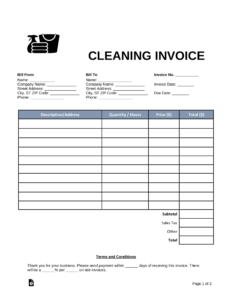In today’s fast-paced digital world, businesses of all sizes rely on efficient and streamlined processes to ensure smooth operations. One vital aspect of any business is the ordering process, which involves the creation and submission of order forms. Order forms serve as a means for customers to request products or services from a company, providing essential information that facilitates the transaction.
Creating a well-designed order form is crucial for businesses as it helps to enhance customer experience, minimize errors, and improve overall efficiency. In this article, we will explore the importance of sample order forms, discuss key elements to include, and provide valuable insights on how to optimize the ordering process. So, whether you are a small business owner or part of a large corporation, read on to discover how sample order forms can simplify your purchasing process.
The Importance of Sample Order Forms
Order forms play a vital role in the overall success of a business. They serve as a direct communication channel between the customer and the company, allowing for a seamless transaction process. Let’s take a closer look at the importance of sample order forms:
1. Enhanced Customer Experience
Sample order forms act as a user-friendly interface that customers can easily navigate. By providing a clear and concise format, order forms simplify the purchasing process for customers, ensuring a positive experience. A well-designed order form reduces confusion, minimizes errors, and saves valuable time for both the customer and the company.
For example, imagine a customer visiting an e-commerce website. Instead of having to manually input their personal and payment information every time they make a purchase, they can simply fill out an order form, pre-populated with their details. This streamlined process not only enhances customer satisfaction but also encourages repeat business.
2. Efficient Order Processing
Sample order forms enable businesses to process orders more efficiently. By standardizing the information required for each order, companies can easily extract and process data, eliminating the need for manual data entry and reducing the risk of errors. Additionally, order forms can be integrated with inventory management systems, enabling real-time updates on product availability and ensuring efficient order fulfillment.
For instance, a company that receives a high volume of orders can use order forms to automate various aspects of the purchasing process. By implementing digital forms that integrate with their inventory management system, they can automatically update stock levels, generate invoices, and track shipments. This automation not only saves time but also reduces the likelihood of errors and delays.
3. Accurate Order Information
Order forms provide a structured format for collecting accurate and complete information from customers. By including specific fields for product details, quantities, delivery addresses, and payment information, businesses can ensure that all necessary information is captured. This reduces the chances of misunderstandings or discrepancies that may arise from incomplete or inaccurate order information.
Consider a scenario where a customer wants to order a customized product with specific requirements. Without an order form, the customer would need to communicate their preferences through email or phone calls, increasing the likelihood of miscommunication or missed details. However, with an order form, customers can clearly specify their preferences, ensuring that the company can fulfill the order accurately and to the customer’s satisfaction.
4. Insights for Business Decisions
Sample order forms can provide valuable insights that help businesses make informed decisions. By analyzing data collected through order forms, companies can gain a deeper understanding of customer preferences, buying patterns, and market demands. This information can then be used to optimize product offerings, pricing strategies, and marketing campaigns.
For example, a company selling clothing can analyze order forms to identify the most popular sizes, colors, or styles. This data can inform inventory planning and help the company focus on products that are in high demand. Additionally, analyzing order forms can reveal trends in customer behavior, allowing businesses to tailor their marketing efforts to specific target audiences.
Key Elements of Sample Order Forms
Now that we understand the importance of sample order forms let’s explore the key elements that should be included to ensure an effective and efficient ordering process:
1. Contact Information
Order forms should include fields for customers to provide their contact information, including their name, email address, phone number, and shipping address. This information is crucial for communicating order updates, confirming purchases, and ensuring accurate delivery.
Example:
- Name: [Text Field]
- Email Address: [Text Field]
- Phone Number: [Text Field]
- Shipping Address: [Text Field]
2. Product Details
Include sections or fields where customers can specify the details of the products they wish to purchase. This may include product names, descriptions, SKU numbers, quantities, sizes, colors, or any other relevant information. Providing clear and specific options ensures that customers can accurately communicate their preferences.
Example:
- Product Name: [Text Field]
- Description: [Text Field]
- SKU Number: [Text Field]
- Quantity: [Number Field]
- Size: [Dropdown Menu]
- Color: [Dropdown Menu]
3. Payment Information
Include a section where customers can provide their payment details. This may include credit card information, PayPal accounts, or any other accepted payment methods. Ensure that the form is secure and compliant with relevant data protection regulations to instill confidence in customers.
Example:
- Credit Card Number: [Text Field]
- Expiration Date: [Text Field]
- CVV: [Text Field]
4. Delivery Options
Offer customers the ability to choose their preferred delivery method, whether it’s standard shipping, express delivery, or in-store pickup. Providing clear options and calculating associated costs, if applicable, helps customers make informed decisions.
Example:
- Delivery Method: [Dropdown Menu]
- Shipping Address: [Text Field]
- Shipping Cost: [Auto-calculated]
5. Additional Instructions
Allow customers to provide any additional instructions or special requests related to their order. This ensures that customers can communicate any specific requirements or preferences that may not be covered by the standard form fields.
Example:
- Additional Instructions: [Text Field]
Optimizing the Ordering Process with Sample Order Forms
While including the key elements mentioned above is essential, there are additional strategies that businesses can employ to optimize the ordering process. Let’s explore some best practices:
1. Clear and Intuitive Design
Avoid overwhelming customers with a cluttered or confusing order form layout. Instead, focus on creating a clean and intuitive design that guides customers through the process effortlessly. Use clear headings, ample spacing, and logical flow to enhance user experience.
2. Mobile-Friendly Experience
With the increasing use of smartphones for online shopping, it is crucial to ensure that your sample order forms are mobile-friendly. Optimize the form’s layout and functionality for smaller screens, making it easy for customers to place orders on the go.
3. Error Prevention and Validation
Implement form validation to minimize errors and ensure accurate data entry. Use error messages and visual cues to alert customers if they have missed required fields or entered information incorrectly. This will help prevent incomplete or inaccurate orders.
4. Auto-population of Customer Information
If customers have previously provided their information, consider implementing auto-population of fields to save them time and effort. This can be achieved by using cookies or secure customer accounts that store their details for future orders.
5. Integration with CRM and Inventory Systems
Integrate your sample order forms with customer relationship management (CRM) and inventory management systems to streamline order processing. This allows for real-time updates on customer information, inventory levels, and order status, enhancing efficiency and reducing manual work.
6. Secure Payment Processing
Ensure that your order forms utilize secure payment processing methods, such as SSL encryption, to protect customer data. Display trust signals, such as security badges or third-party payment logos, to instill confidence in customers and increase conversion rates.
7. Order Confirmation and Communication
Send automated order confirmation emails to customers upon successful submission of an order. Provide detailed information about the order, including a summary of the items, payment details, estimated delivery dates, and any additional instructions. Promptly communicate any updates or changes to the order to keep customers informed.
Conclusion
Sample order forms are an essential tool for businesses looking to simplify their purchasing process. By enhancing customer experience, improving efficiency, ensuring accurate order information, and providing insights for business decisions, order forms play a crucial role in the overall success of a company.
When creating sample order forms, it is important to include key elements such as contact information, product details, payment information, delivery options, and space for additional instructions. Optimizing the ordering process with clearand intuitive design, mobile-friendly experience, error prevention and validation, auto-population of customer information, integration with CRM and inventory systems, secure payment processing, and effective order confirmation and communication can further enhance the effectiveness of order forms.
By implementing these best practices, businesses can streamline their ordering process, minimize errors, and provide a seamless experience for their customers. This not only leads to higher customer satisfaction but also increases the likelihood of repeat business and positive word-of-mouth recommendations.
FAQs (Frequently Asked Questions)
1. Why is it important to have a sample order form?
A sample order form is important because it provides a structured format for customers to request products or services from a company. It helps ensure accurate order information, enhances customer experience, and streamlines the ordering process.
2. How can I design a user-friendly order form?
To design a user-friendly order form, focus on clarity and simplicity. Use clear headings, logical flow, and intuitive design elements. Optimize the form for mobile devices and implement error prevention and validation techniques.
3. Can order forms be integrated with CRM and inventory systems?
Yes, order forms can be integrated with customer relationship management (CRM) and inventory systems. This integration allows for real-time updates on customer information, inventory levels, and order status, enhancing efficiency and minimizing manual work.
4. How can order forms help businesses make informed decisions?
By analyzing data collected through order forms, businesses can gain insights into customer preferences, buying patterns, and market demands. This information can be used to optimize product offerings, pricing strategies, and marketing campaigns.
5. Are secure payment processing methods important for order forms?
Yes, secure payment processing methods are crucial for order forms. Utilizing SSL encryption, displaying trust signals, and implementing secure payment gateways help protect customer data and increase trust and confidence in the ordering process.
Summary
Sample order forms are a valuable tool for businesses to simplify and optimize the purchasing process. By enhancing customer experience, improving efficiency, ensuring accurate order information, and providing insights for business decisions, order forms play a crucial role in the success of a company.
To create effective order forms, it is important to include key elements such as contact information, product details, payment information, delivery options, and space for additional instructions. By optimizing the ordering process with clear and intuitive design, mobile-friendly experience, error prevention and validation, auto-population of customer information, integration with CRM and inventory systems, secure payment processing, and effective order confirmation and communication, businesses can further enhance the effectiveness of their order forms.
By implementing these best practices, businesses can streamline their ordering process, minimize errors, and provide a seamless experience for their customers. This leads to higher customer satisfaction, repeat business, and positive word-of-mouth recommendations, ultimately contributing to the growth and success of the business.





